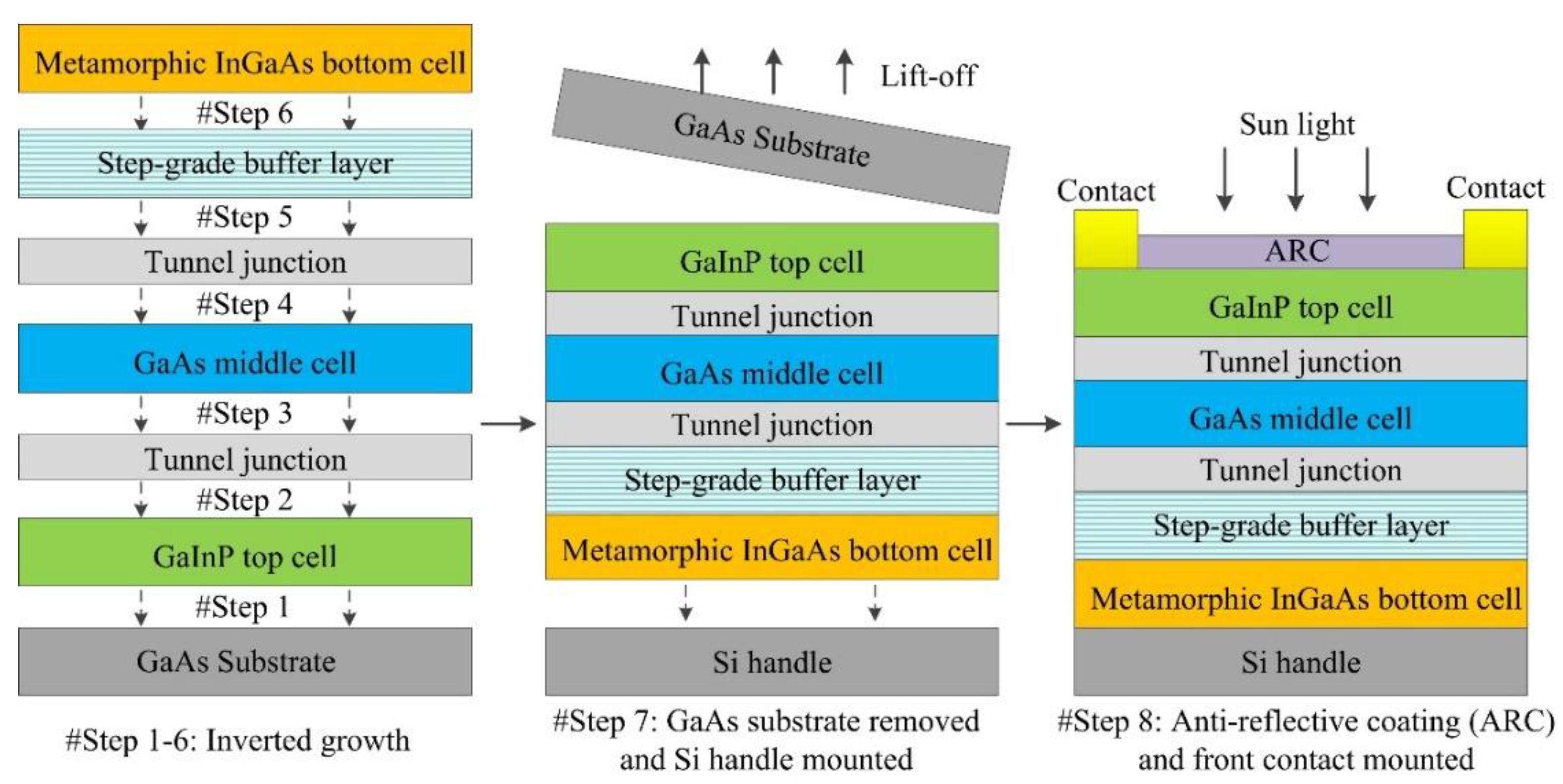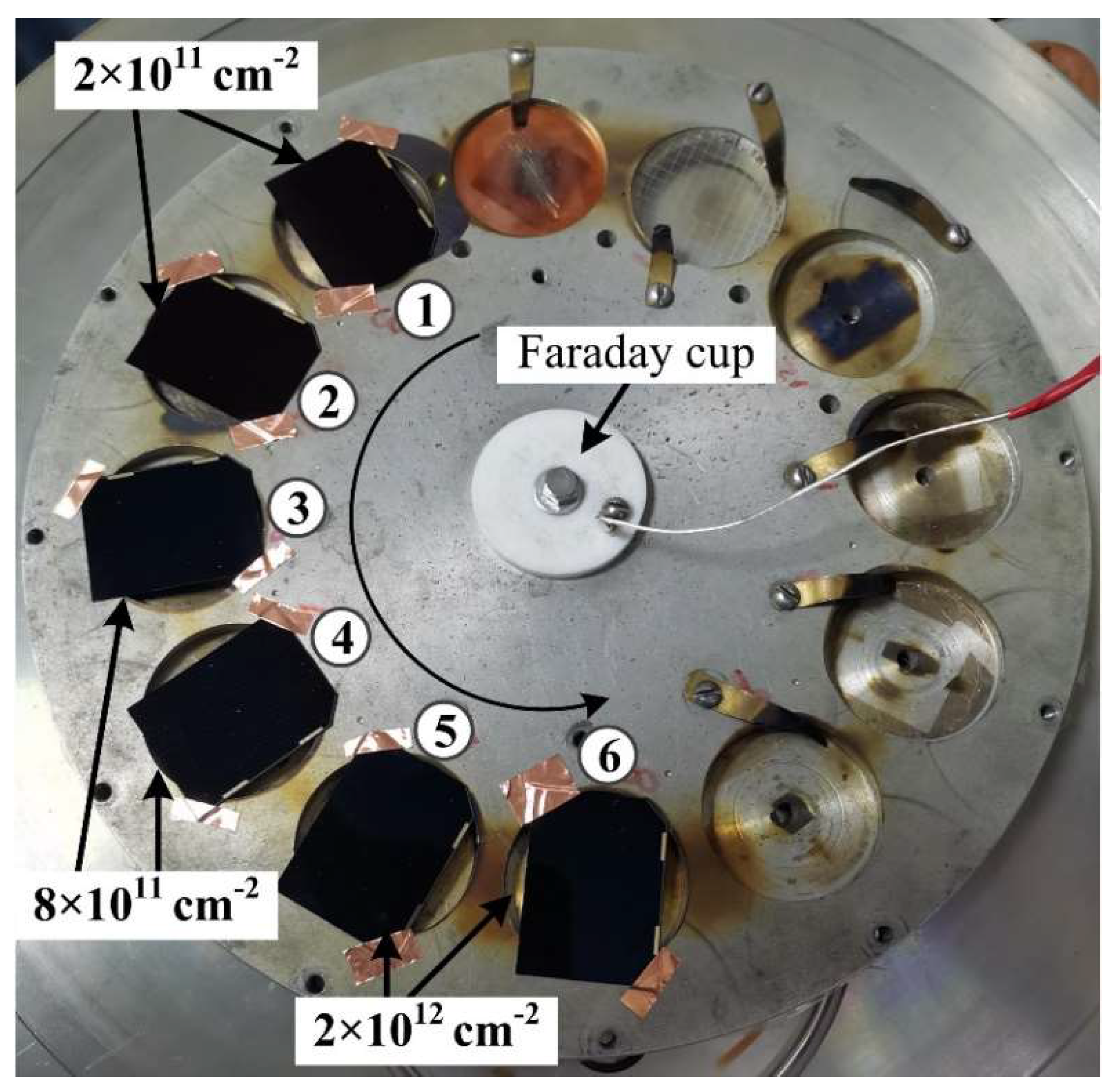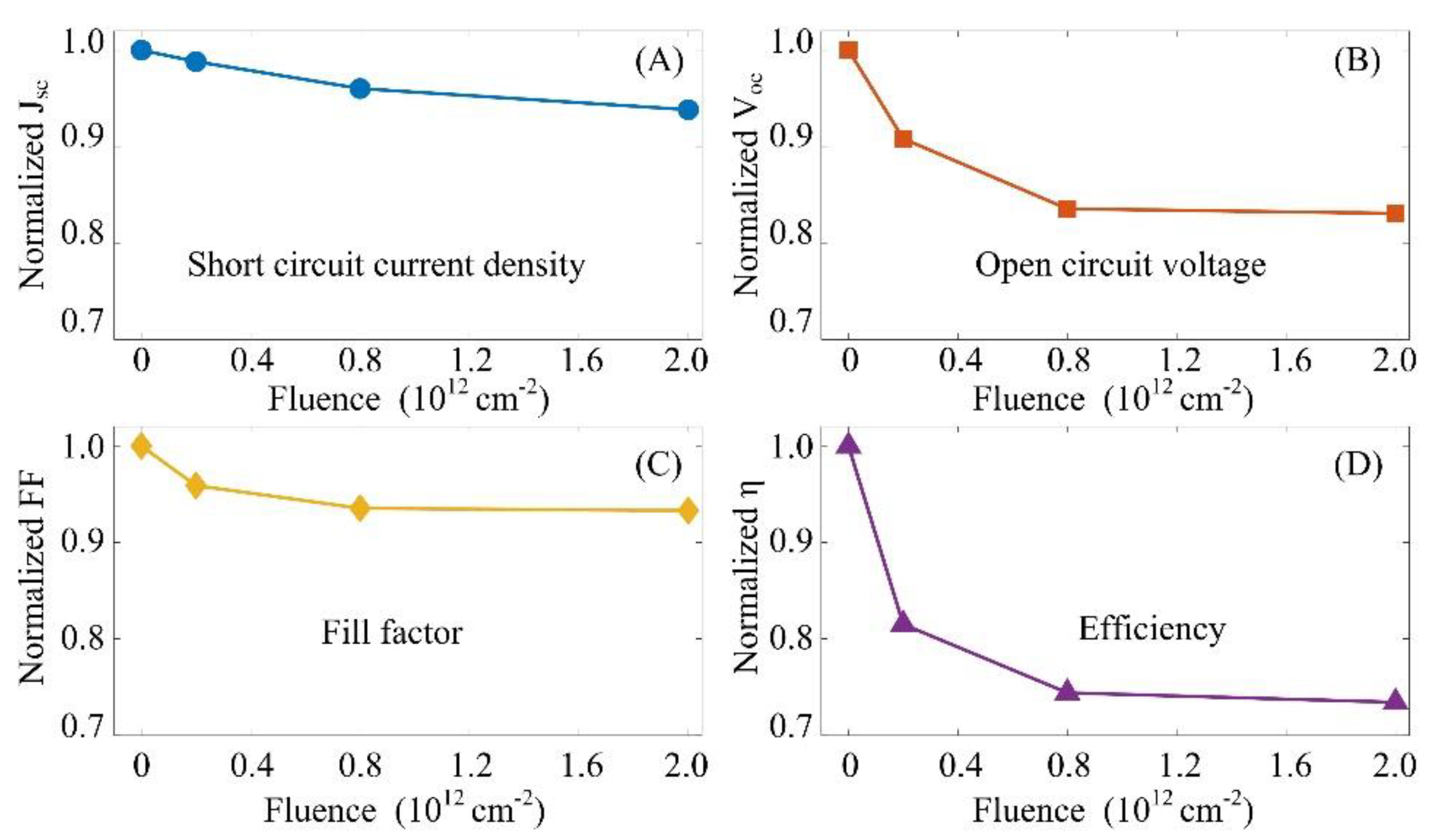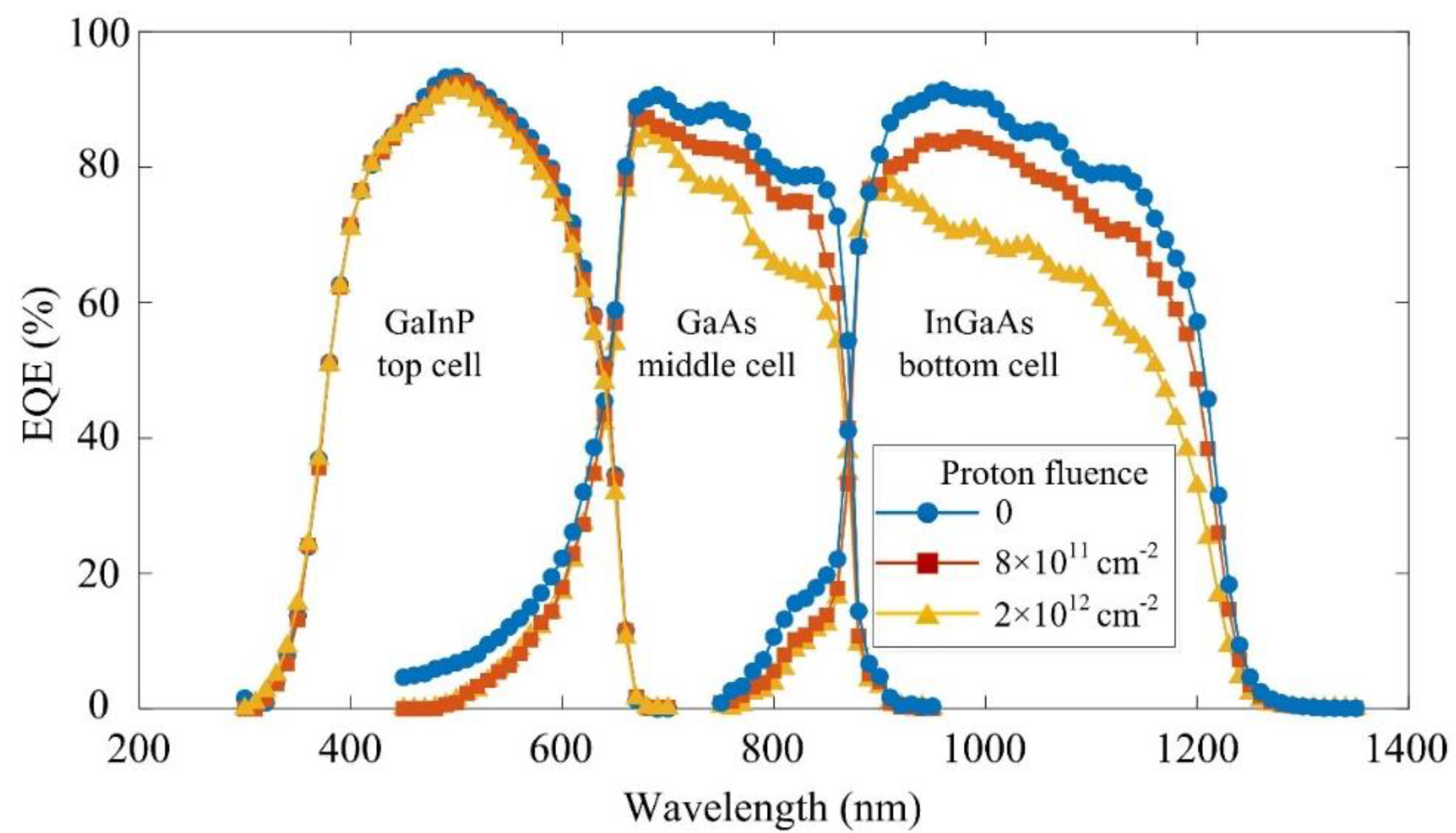Fabrication and Irradiation Effect of Inverted Metamorphic Triple Junction GaInP/GaAs/InGaAs Solar Cells
Abstract
:1. Introduction
2. Materials and Methods
2.1. The Fabrication of the IMM3J Solar Cell
2.2. Proton Irradiation Experiment
2.3. Characterization of the IMM3J Solar Cell
3. Results
3.1. IMM3J Solar Cell Performance at the Beginning of Life
3.2. IMM3J Solar Cell Performance at the End of Life
4. Discussion and Conclusions
Author Contributions
Funding
Data Availability Statement
Conflicts of Interest
References
- Strobl, G.; Dietrich, R.; Hilgarth, J.; Kostler, W.; Kern, R.; Nell, M.; Rothenbacher, S.; Bett, A.; Dimroth, F.; Meusel, M. Advanced GaInP/Ga (In) As/Ge triple junction space solar cells. In Proceedings of the 3rd World Conference onPhotovoltaic Energy Conversion, Osaka, Japan, 11–18 May 2003; pp. 658–661. [Google Scholar]
- Ochoa, M.; Yaccuzzi, E.; Espinet-González, P.; Barrera, M.; Barrigón, E.; Ibarra, M.L.; Contreras, Y.; Garcia, J.; López, E.; Alurralde, M. 10 MeV proton irradiation effects on GaInP/GaAs/Ge concentrator solar cells and their component subcells. Sol. Energy Mater. Sol. Cells 2017, 159, 576–582. [Google Scholar] [CrossRef] [Green Version]
- Xu, J.; Guo, M.; Lu, M.; He, H.; Yang, G.; Xu, J. Effect of Alpha-Particle Irradiation on InGaP/GaAs/Ge Triple-Junction Solar Cells. Materials 2018, 11, 944. [Google Scholar] [CrossRef] [PubMed] [Green Version]
- Yamaguchi, M. III–V compound multi-junction solar cells: Present and future. Sol. Energy Mater. Sol. Cells 2003, 75, 261–269. [Google Scholar] [CrossRef]
- Guter, W.; Schöne, J.; Philipps, S.P.; Steiner, M.; Siefer, G.; Wekkeli, A.; Welser, E.; Oliva, E.; Bett, A.W.; Dimroth, F. Current-matched triple-junction solar cell reaching 41.1% conversion efficiency under concentrated sunlight. Appl. Phys. Lett. 2009, 94, 223504. [Google Scholar] [CrossRef]
- Uesugi, K.; Kuboya, S.; Sanorpim, S.; Onabe, K. Characterization of InGaAsN solar-cell structures on Ge substrates. Phys. Status Solidi 2014, 11, 561–564. [Google Scholar] [CrossRef]
- Sukeerthi, M.; Kotamraju, S.; Meetei, R.; Rao, P.N. Degradation analysis of 3J InGaP/InGaAs/InGaAsN solar cell due to irradiation induced defects with a comparative study on bottom homo and hetero InGaAsN subcell. Sol. Energy 2018, 174, 728–734. [Google Scholar] [CrossRef]
- Sukeerthi, M.; Kotamraju, S. Study of degradation in 3J inverted metamorphic (IMM) solar cell due to irradiation-induced deep level traps and threading dislocations using finite element analysis. Physica E 2021, 127, 114566. [Google Scholar] [CrossRef]
- Geisz, J.; Kurtz, S.; Wanlass, M.; Ward, J.; Duda, A.; Friedman, D.; Olson, J.; McMahon, W.; Moriarty, T.; Kiehl, J. High-efficiency Ga In P∕ Ga As∕ In Ga As triple-junction solar cells grown inverted with a metamorphic bottom junction. Appl. Phys. Lett. 2007, 91, 023502. [Google Scholar] [CrossRef]
- France, R.M.; García, I.; McMahon, W.E.; Norman, A.G.; Simon, J.; Geisz, J.F.; Friedman, D.J.; Romero, M.J. Lattice-mismatched 0.7-eV GaInAs solar cells grown on GaAs using GaInP compositionally graded buffers. IEEE J. Photovolt. 2013, 4, 190–195. [Google Scholar] [CrossRef]
- Adams, J.G.; Elarde, V.C.; Hillier, G.; Stender, C.; Tuminello, F.; Wibowo, A.; Youtsey, C.; Bittner, Z.; Hubbard, S.M.; Clark, E.B. Improved radiation resistance of epitaxial lift-off inverted metamorphic solar cells. In Proceedings of the 2013 IEEE 39th Photovoltaic Specialists Conference (PVSC), Tampa, FL, USA, 16–21 June 2013; pp. 3229–3232. [Google Scholar]
- Wang, B.; Fang, L.; Aierken, A.; Tang, Z.; Du, W.; He, J.; Huang, J.; Huang, H.; Yang, W.; Chen, K. Effects of Zn diffusion in tunnel junction and its solution for high efficiency large area flexible GaInP/GaAs/InGaAs tandem solar cell. Sol. Energy Mater. Sol. Cells 2021, 230, 111257. [Google Scholar] [CrossRef]
- Li, J.; Aierken, A.; Zhuang, Y.; Xu, P.; Wu, H.; Zhang, Q.; Wang, X.; Mo, J.; Yang, X.; Chen, Q. 1 MeV electron and 10 MeV proton irradiation effects on inverted metamorphic GaInP/GaAs/InGaAs triple junction solar cell. Sol. Energy Mater. Sol. Cells 2021, 224, 111022. [Google Scholar] [CrossRef]
- Takamoto, T.; Washio, H.; Juso, H. Application of InGaP/GaAs/InGaAs triple junction solar cells to space use and concentrator photovoltaic. In Proceedings of the 2014 IEEE 40th Photovoltaic Specialist Conference (PVSC), Denver, CO, USA, 8–13 June 2014; pp. 0001–0005. [Google Scholar]
- Boisvert, J.; Law, D.; King, R.; Rehder, E.; Chiu, P.; Bhusari, D.; Fetzer, C.; Liu, X.; Hong, W.; Mesropian, S. High efficiency inverted metamorphic (IMM) solar cells. In Proceedings of the 2013 IEEE 39th Photovoltaic Specialists Conference (PVSC), Tampa, FL, USA, 16–21 June 2013; pp. 2790–2792. [Google Scholar]
- Li, J.; Aierken, A.; Liu, Y.; Zhuang, Y.; Yang, X.; Mo, J.; Fan, R.; Chen, Q.; Zhang, S.; Huang, Y. A brief review of high efficiency iii-v solar cells for space application. Front. Phys. 2021, 8, 631925. [Google Scholar] [CrossRef]
- Imaizumi, M.; Nakamura, T.; Takamoto, T.; Ohshima, T.; Tajima, M. Radiation degradation characteristics of component subcells in inverted metamorphic triple-junction solar cells irradiated with electrons and protons. Prog. Photovolt. 2017, 25, 161–174. [Google Scholar] [CrossRef]
- Schön, J.; Bissels, G.M.; Mulder, P.; van Leest, R.H.; Gruginskie, N.; Vlieg, E.; Chojniak, D.; Lackner, D. Improvements in ultra-light and flexible epitaxial lift-off GaInP/GaAs/GaInAs solar cells for space applications. Prog. Photovolt. 2022. [Google Scholar] [CrossRef]
- Zhang, Y.; Wu, Y.; Zhao, H.; Sun, C.; Xiao, J.; Geng, H.; Xue, J.; Lu, J.; Wang, Y. Degradation behavior of electrical properties of inverted metamorphic tri-junction solar cells under 1 MeV electron irradiation. Sol. Energy Mater. Sol. Cells 2016, 157, 861–866. [Google Scholar] [CrossRef]
- Zhang, Y.; Qi, C.; Wang, T.; Ma, G.; Tsai, H.-S.; Liu, C.; Zhou, J.; Wei, Y.; Li, H.; Xiao, L. Electron Irradiation Effects and Defects Analysis of the Inverted Metamorphic Four-Junction Solar Cells. IEEE J. Photovolt. 2020, 10, 1712–1720. [Google Scholar] [CrossRef]
- Rong, W.; Yunhong, L.; Xufang, S. Effects of 0.28–2.80MeV proton irradiation on GaInP/GaAs/Ge triple-junction solar cells for space use. Nucl. Instrum. Methods Phys. Res. Sect. B 2008, 266, 745–749. [Google Scholar] [CrossRef]
- Song, M.-H.; Wang, D.-X.; Bi, J.-F.; Chen, W.-J.; Li, M.-Y.; Li, S.-L.; Liu, G.-Z.; Wu, C.-Y. Inverted metamorphic triple-junction solar cell and its radiation hardness for space applications. Acta Phys. Sin. 2017, 66, 18. [Google Scholar]
- Hovel, H.J. Semiconductors and semimetals. Sol. Cells 1975, 11, 7284142. [Google Scholar]
- Jianmin, H.; Yiyong, W.; Jingdong, X.; Dezhuang, Y.; Zhongwei, Z. Degradation behaviors of electrical properties of GaInP/GaAs/Ge solar cells under < 200 keV proton irradiation. Sol. Energy Mater. Sol. Cells 2008, 92, 1652–1656. [Google Scholar] [CrossRef]
- Wang, J.; Yan, G.; Wu, R.; Wang, R. Electron-induced degradation of JV characteristics of GaInP top cell and GaAs middle cell by electroluminescence measurements. J. Appl. Phys. 2018, 123, 205704. [Google Scholar] [CrossRef]
- Cariou, R.; Medjoubi, K.; Vauche, L.; Veinberg-Vidal, E.; Park, S.; Lefèvre, J.; Baudrit, M.; Voarino, P.; Mur, P.; Boizot, B. Evaluation of III–V/Si multi-junction solar cells potential for space. In Proceedings of the 2018 IEEE 7th World Conference on Photovoltaic Energy Conversion (WCPEC) (A Joint Conference of 45th IEEE PVSC, 28th PVSEC & 34th EU PVSEC), Waikoloa, HI, USA, 10–15 June 2018; pp. 3335–3338. [Google Scholar]
- Zaidi, M.; Zazoui, M.; Bourgoin, J. Defects in electron irradiated GaInP. J. Appl. Phys. 1993, 73, 7229–7231. [Google Scholar] [CrossRef]
- Pons, D.; Bourgoin, J. Irradiation-induced defects in GaAs. J. Phys. C 1985, 18, 3839. [Google Scholar] [CrossRef]
- Bourgoin, J.; Zazoui, M. Irradiation-induced degradation in solar cell: Characterization of recombination centres. Semicond. Sci. Technol. 2002, 17, 453. [Google Scholar] [CrossRef]






Publisher’s Note: MDPI stays neutral with regard to jurisdictional claims in published maps and institutional affiliations. |
© 2022 by the authors. Licensee MDPI, Basel, Switzerland. This article is an open access article distributed under the terms and conditions of the Creative Commons Attribution (CC BY) license (https://creativecommons.org/licenses/by/4.0/).
Share and Cite
Xu, J.; Yang, K.; Xu, Q.; Zhu, X.; Wang, X.; Lu, M. Fabrication and Irradiation Effect of Inverted Metamorphic Triple Junction GaInP/GaAs/InGaAs Solar Cells. Crystals 2022, 12, 670. https://doi.org/10.3390/cryst12050670
Xu J, Yang K, Xu Q, Zhu X, Wang X, Lu M. Fabrication and Irradiation Effect of Inverted Metamorphic Triple Junction GaInP/GaAs/InGaAs Solar Cells. Crystals. 2022; 12(5):670. https://doi.org/10.3390/cryst12050670
Chicago/Turabian StyleXu, Jing, Kunjie Yang, Qingguo Xu, Xiaofang Zhu, Xin Wang, and Ming Lu. 2022. "Fabrication and Irradiation Effect of Inverted Metamorphic Triple Junction GaInP/GaAs/InGaAs Solar Cells" Crystals 12, no. 5: 670. https://doi.org/10.3390/cryst12050670
APA StyleXu, J., Yang, K., Xu, Q., Zhu, X., Wang, X., & Lu, M. (2022). Fabrication and Irradiation Effect of Inverted Metamorphic Triple Junction GaInP/GaAs/InGaAs Solar Cells. Crystals, 12(5), 670. https://doi.org/10.3390/cryst12050670





